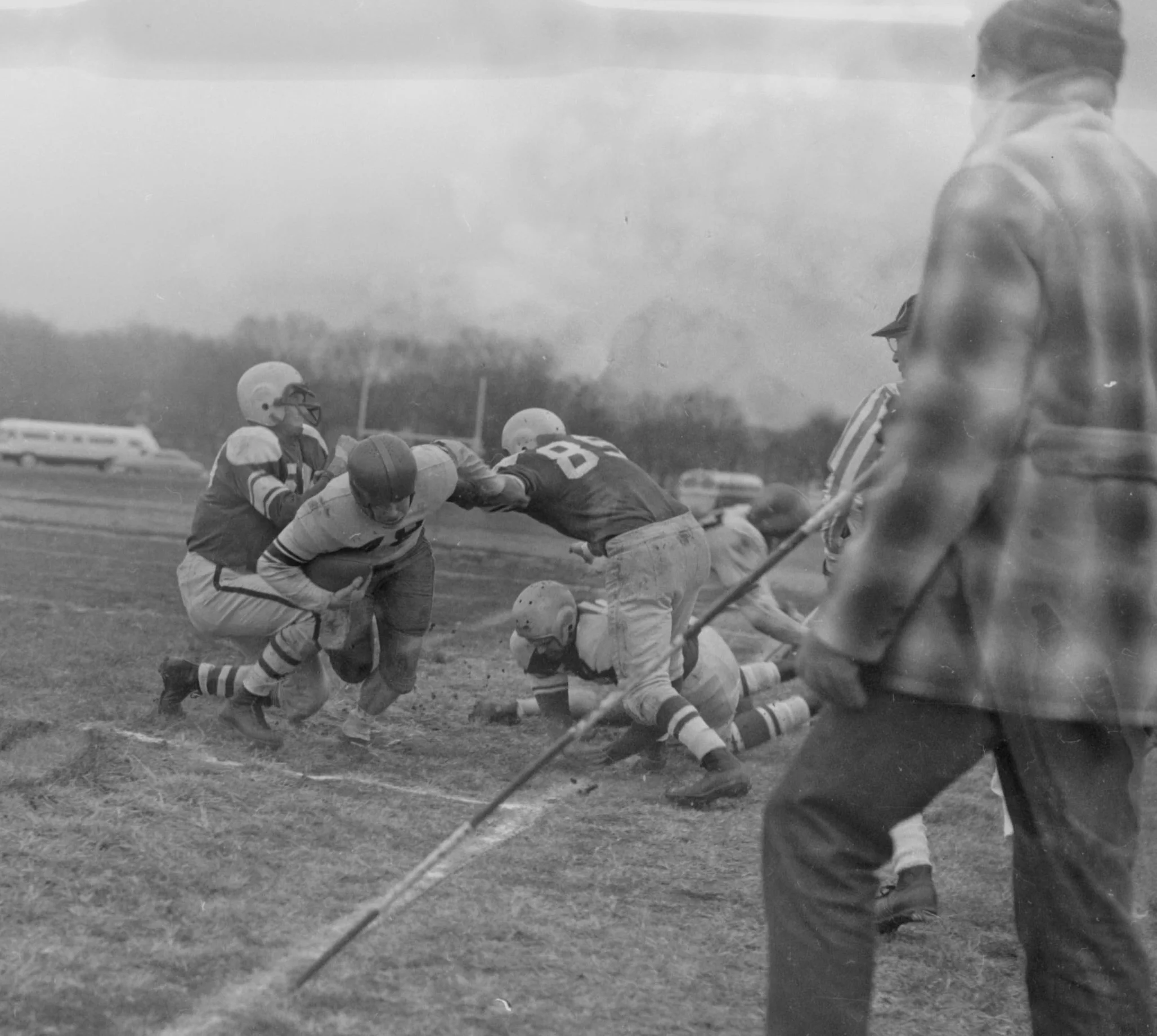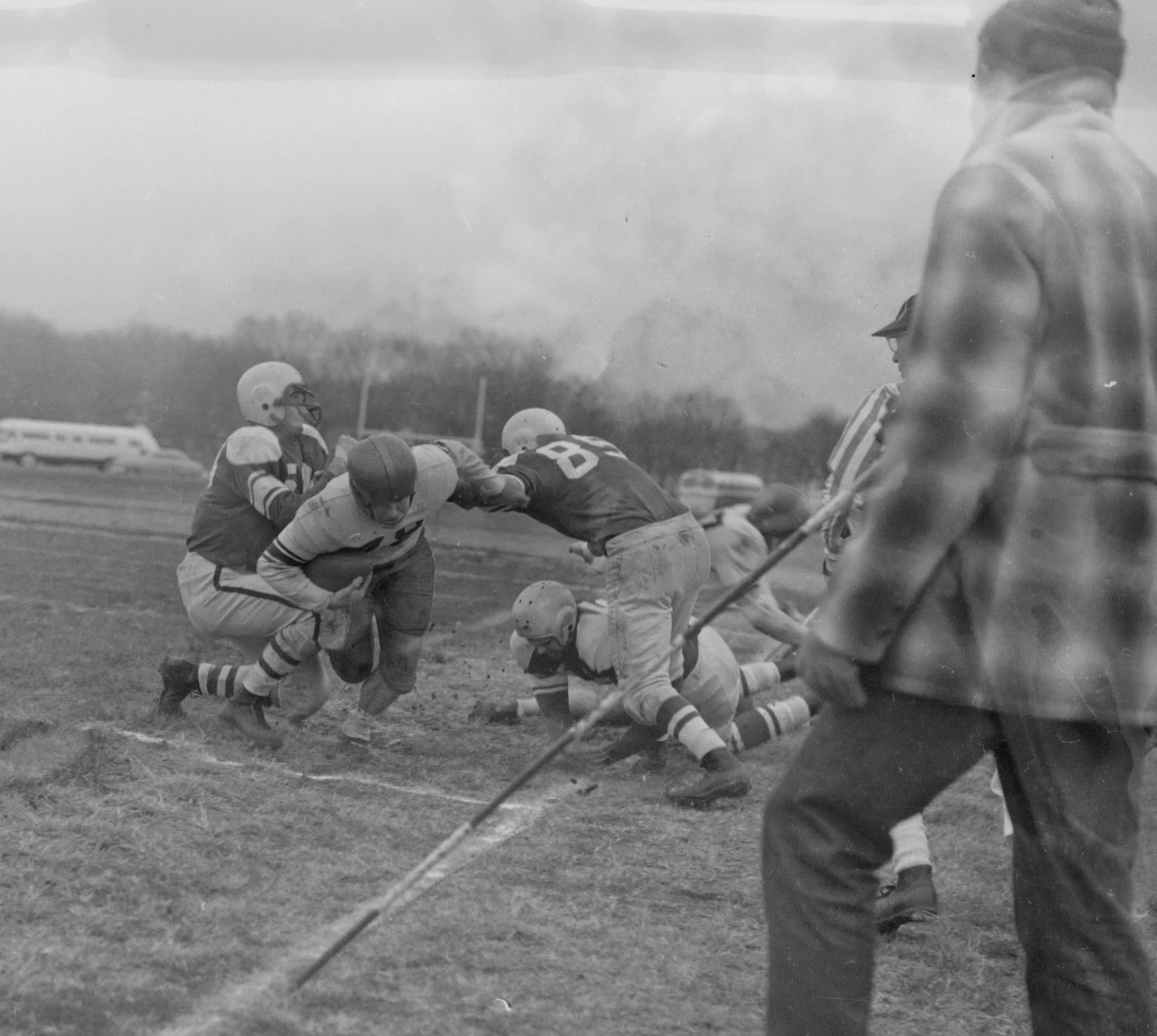Sixty-six years ago this week—Thanksgiving Day, Nov. 26, 1953—a disappointingly small crowd was on hand to watch the last Corn Bowl in Bloomington.
What’s that you say? Never heard of the Corn Bowl? Well, that’s not surprising, as it’s one of many long-gone, small-time holiday bowl games scattered across college football’s storied past.
Between 1947 and 1953, there were six Corn Bowl games held in Bloomington. Local organizers believed hosting a Thanksgiving Day college football game would prove a boon to local businesses, as well as a smart public relations move for the community as a whole.
In the lead up to the inaugural Corn Bowl, the game’s then-general chairman, A.B. Perry, envisioned the erection of a 150,000-seat football stadium to host the annual Turkey Day tussle. And since the bowl game enjoyed the sponsorship of hybrid corn breeders--including Pfister and Funk Bros. Seed Co.—Perry also thought the stadium could be used for agricultural fairs and exhibitions. Suffice to say, no colossal Corn Bowl was ever built in the Twin Cities or elsewhere (today, the largest sports venue in the U.S. is Michigan Stadium in Ann Arbor, with an official capacity of 107,600.)
Perry’s exuberant vision notwithstanding, the first Corn Bowl—Southern Illinois University’s 21-0 victory over North Central College of Naperville—was held at Bloomington High School’s Fred Carlton Field, a far cry from any bowl or college stadium of any respectable size. An estimated 5,500 spectators braved the wet snow and cold drizzle typical to many Central Illinois Thanksgivings.
Although the game fell far short of big-time bowl expectations, the pre-game, Thanksgiving morning Corn Bowl parade was an unqualified success. Some 30,000 folks lined the streets of downtown Bloomington to catch sight of 90-plus floats and seven bands in what The Pantagraph called “the longest and best parade ever held in Bloomington.”
For the 1948 Corn Bowl the following year, some 8,400 spectators watched Illinois Wesleyan University beat Eastern Illinois State College (now EIU) 6-0. The second game in the series was the first to be played at IWU’s own football field (now known as Tucci Stadium).
Never again would Corn Bowl organizers sell as many tickets as they did in 1948. In the end, the bowl could not overcome the twin obstacles of late-November Midwestern weather and the lack big-time football programs and their promise of drawing power and gate receipts.
The first and fourth games in the series were played in snow and ice; the third in a cold rain; and the fifth in snow and bitter cold. And IWU and EIU—though both schools boast rich football traditions and histories—have never challenged the likes of UCLA or Notre Dame when it comes to national name recognition.
After a one-year hiatus, the Corn Bowl returned in 1953 for what would prove to be the sixth and final such game held in Bloomington. Community wide enthusiasm for the bowl game had cooled considerably since its inception and early expectations. The 1953 Corn Bowl, for instance, did not include a parade. And the previous game, in 1951, included a weighty 50-plus page program. There would be no such souvenir tome for the 1953 contest.
For much of the bowl’s history, the American Legion Louis E. Davis Post 56 of Bloomington served as the principal sponsor. The game doubled as a fundraiser for the post, with the proceeds from ticket sales in 1953 going to the American Legion’s junior baseball program.
For the 1953 Corn Bowl, the 25-member organizing committee paired Iowa Wesleyan College in Mt. Pleasant, Iowa, against Western Illinois State Teachers College in Macomb (now WIU.)
The Tigers of Iowa Wesleyan, champions of the Iowa Intercollegiate Athletic Association, claimed a roster with players from nearly a dozen states, with the Illinois contingent including at least ten Chicagoans. Western Illinois finished the Interstate Intercollegiate Athletic Conference in second place, trailing only Central Michigan College of Education (now Central Michigan University.)
Let it be said that the Corn Bowl was not the only such game overshadowed by the giants of the holiday bowl season, such as the Orange (Miami, Fla.), Sugar (New Orleans) and Rose (Pasadena, Cal.) bowls. In 1953, for instance, there was the Refrigerator Bowl in Evansville, Ind., featuring Sam Houston State and the College of Idaho, while the Olive Bowl in Lindsay, Cal., pitted—pun intended!—La Verne College against the College of the Sequoias.
Once more, chilly weather and snow depressed Corn Bowl attendance. The 2,500 spectators for the 1953 Corn Bowl represented a “fair-sized crowd,” noted one clearly charitable observer. The snow arrived around halftime, and it continued to fall through the entire second half. “The weatherman apparently has a curse on the Thanksgiving Day classic,” grumbled The Pantagraph.
Snow or no snow, the Leathernecks captured the sixth Corn Bowl title with dominating offensive and defensive lines—winning the “war in the trenches” as it’s said in the parlance of the game. “Leathernecks chew up Iowans,” was the headline for Pantagraph sports editor Fred Young’s post-game analysis. Young credited defensive ends Ray Pearson of Moline and Willie Grant of Hot Springs, Ark. for keeping Tigers quarterback Dick Schmitt on the run for most of the contest.
The overmatched Iowa Wesleyan offense managed only 46 yards on 6 of 22 passing, and 80 yards on the ground during a frustrating afternoon that included only 5 first downs. “The boys ‘up front,’” declared Young of linemen, “are always the deciding factor.”
Meanwhile, speedy senior halfback Mike Reynolds of Spring Valley—all 5 ft. 7 inches and 175 pounds of him—reached the Tigers end zone four times. His first touchdown came on a 10-yard pass from QB Ted Mullen; the next two from runs of 18 and 21 yards, and the last on a 55-yard punt return.
It was an easy call for the eleven newspaper writers and “radio men” in the press box and along the sidelines to pick Reynolds as the game’s most valuable player, and as such recipient of the Sigmund Sorg MVP trophy (named for a Bloomington jeweler and bowl sponsor.)
After the game, the Louis Davis Post hosted a banquet at the McBarnes Memorial Building on East Grove Street in downtown Bloomington, with players and coaching staffs from both schools feted with a turkey dinner.
After another one-year hiatus, the Corn Bowl returned for a seventh time in what would prove to be its last hurrah. The relocated Thanksgiving Day game was held in Macomb, as the hometown Leathernecks fell to Luther College of Decorah, Ia. by a score of 24-20.

